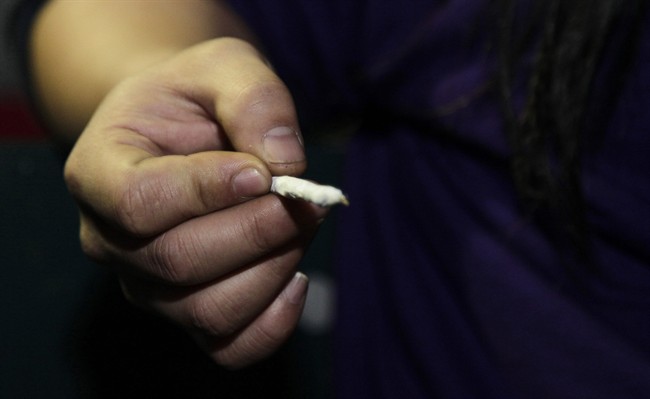There is a mixture of good and bad news in the latest data released by Health Canada on rates of smoking, drinking and drug use among school-aged kids.

The results of the 2014-15 Canadian Student Tobacco, Alcohol, and Drugs Survey were made public on Wednesday, and they show that while smoking rates continue to drop, more and more kids are experimenting with prescription drugs.
Overall, Health Canada says, the number of young smokers (Grades 6-12) is falling steadily, down from four per cent of the students surveyed in 2012-13 to three per cent in the 2014-15 school year.
WATCH: Does the Canadian Medical Association’s pot smoking age make sense?

But slightly more young people (seven per cent) reported using a flavoured tobacco product in the 30 days before they were surveyed, and three per cent reported using menthol cigarettes. That’s compared to eight per cent and three per cent the previous year, respectively.
Marijuana was much more widespread in the cohort, with 17 per cent of students in Grades 7 to 12 confirming they had gotten high within the past year. More than half of the teens — 58 per cent — said they believe smoking pot regularly puts people at “great risk” of harm.

Get weekly health news
“Rates of tobacco use are generally higher among male students, and male students report first trying alcohol and cannabis at a slightly younger age than females,” Health Canada’s summary of the report states.
Fentanyl finds its way into high schools
While smoking seems to be on the wane, the department is tracking an increase in the use of synthetic cannabinoids. These are man-made chemicals designed to mimic marijuana, also known as “spice” or “K2,” that can be either smoked or sold as liquids to be vaporized.
Reported use of synthetic cannabinoids jumped from one per cent to four per cent year-over-year, and the drugs now have the third-highest prevalence of past 12-month use among Canadian students in Grades 7 to 12, after alcohol and marijuana.
READ MORE: RCMP officers tell their story of being exposed to fentanyl
The other popular way to get high is through the abuse of psychoactive pharmaceuticals (sedatives/tranquilizers, stimulants and prescribed pain relievers), with reported use among high schoolers also sitting at four per cent.
This number was unchanged from 2012-13, but a decrease from six per cent in 2010-11.
“For the first time, the prevalence of past year abuse of oxycodone (one per cent) and of fentanyl (0.4 per cent) were measured separately from other prescribed pain relievers,” Health Canada noted.
Because use of Fentanyl, the dangerous drug behind hundreds of overdose deaths in Canada over the past year, wasn’t measured separately in 2012-13, it’s impossible to know if more teens are using it than before.
Alcohol still popular
Underage drinking remains widespread among youth in Grades 7 to 12, the survey results show, although the rates of use have taken a dive over the past five years. In 2008-09, over half (53 per cent) of students said they drank, and last year it was steady at 40 per cent.
On average, students tried their first alcoholic beverage at 13.5 years of age.
WATCH: How to have hard conversations with junior high students

In a statement, Health Minister Jane Philpott said she was “encouraged” to see smoking rates and the use of some drugs declining among youth.
“(This) is a testament to the effectiveness of our collective efforts in public health and education,” she said.
“However, these results also indicate the need for continued efforts in these areas, including on opioid misuse and flavoured tobacco, two areas where our government is taking action.”
The Liberal government has proposed a Canada-wide ban on menthol cigarettes and says it will introduce plain-packaging requirements for tobacco products.
More than 42,000 students responded to the Health Canada survey, conducted by the Propel Centre for Population Health Impact at the University of Waterloo on behalf of the department. Only students in Grades 7 to 12 were asked questions about drugs and alcohol.








Comments